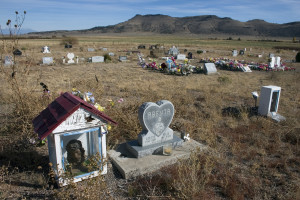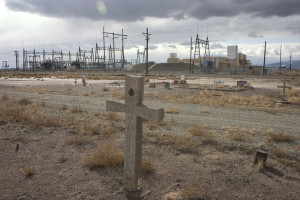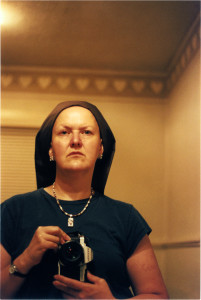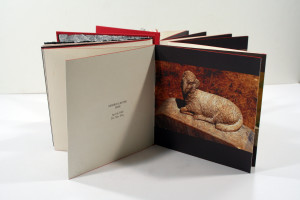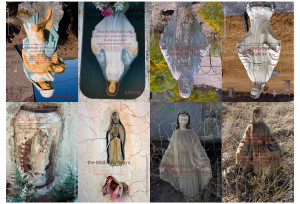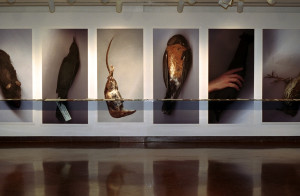 Photographer, printmaker, graphic designer, and book artist Kathy Hettinga is on familiar terms with death. While very young, she lost her husband in a farming accident, and she has survived cancer. As an artist, she approaches her old acquaintance with clear-eyed delicacy. Like Emily Dickinson, she seems able to look at death with respect but without fear. Serene and understated, Hettinga brings a classical sense of dignity to all her subject matter, from enormous, lusciously detailed photographs of tiny dead animals to books of southwest American funerary art, to Seen, CIVA’s handsome quarterly. Her images guide us gently but insistently to confront what we usually work hard to avoid thinking about: that death comes for the young and old, the powerful and the helpless, the fierce and the innocent. And though she never gives short shrift to the realities of suffering, a deep sense of peace underlies all her work, even the most painful subject matter. The photos, books, and prints convey the force of our fear and bewilderment over death, but they also offer glimmers of a deeper and more mysterious hope. Hettinga’s work breathes with the confidence and peace of an old soul.
Photographer, printmaker, graphic designer, and book artist Kathy Hettinga is on familiar terms with death. While very young, she lost her husband in a farming accident, and she has survived cancer. As an artist, she approaches her old acquaintance with clear-eyed delicacy. Like Emily Dickinson, she seems able to look at death with respect but without fear. Serene and understated, Hettinga brings a classical sense of dignity to all her subject matter, from enormous, lusciously detailed photographs of tiny dead animals to books of southwest American funerary art, to Seen, CIVA’s handsome quarterly. Her images guide us gently but insistently to confront what we usually work hard to avoid thinking about: that death comes for the young and old, the powerful and the helpless, the fierce and the innocent. And though she never gives short shrift to the realities of suffering, a deep sense of peace underlies all her work, even the most painful subject matter. The photos, books, and prints convey the force of our fear and bewilderment over death, but they also offer glimmers of a deeper and more mysterious hope. Hettinga’s work breathes with the confidence and peace of an old soul.
Some of Hettinga’s work is featured in Image issue 66. Read an excerpt from Karen Mulder’s essay on Hettinga’s work here and a web exclusive interview with Hettinga here.
Biography
Kathy Hettinga has received many awards and honors for her artwork, including an Indiana Arts Fellowship, a Research Fellowship at The Institute of Sacred Music, Worship, and the Arts at Yale University, and a Scholar Chair from Messiah University. Her work is in the permanent collections of UCLA, the Armand Hammer Museum, the New York Public Library, and the Art of the Book collection at Yale University. She is the design director for CIVA and an art professor at Messiah College. In her interview with Image, she spoke about art as a means of justice and why she loves to photograph cemeteries.
Current Projects
May 2011
Photographing cemeteries is a passion of mine. There you find the collision of faith and death, tragedy and hope, mystery and physicality. On my travels I have photographed cemeteries in Australia, Russia, Azerbaijan, the Bahamas, and Colombia.
Another project, a book of prayers, is in its beginning stages. Many prayers reveal the universal human pattern of hope in the face of tragedy, and also show the frequent fragility of the human condition—each of us, at any given moment, so near to any number of ailments or predicaments. An artist’s book is the perfect medium for the cancer experience, too—as it can show the scientific wonder of cells and chemotherapy, along with the dark side of balancing contradictory medicines; a wide range of human pathos, evoking pity and compassion and humor in the objects and photos.
I collaborated with an arts group and a social justice organization to design Middle East Baltimore: Stories, Words and Images from a Displaced Community—a book that provides a visual and audio record of a Baltimore neighborhood that endured eminent domain being placed on it by a private corporation. The book tells the stories of the over 800 poor, predominately African-American families whose homes the developers took over.
The work that I am making and pursuing crosses the boundaries of printmaking, photography, drawing, and collage. I have long been interested in new ways to work with digital prints to increase the rich surface in a way that is integral to the work, not just a scratching of the surface.
I just wrote an essay on my work at seminaries–Yale Divinity School and Wesley Theological Union; I am in the midst of designing an issue for SEEN Journal; I have an upcoming show at Messiah College which will feature wall size prints of ground covers from cemeteries; and I recently finished a workshop at Women’s Studio Workshop on trace mono-prints, paper lithography and encaustic transfer. I am also working on an artist’s book about an abandoned lake resort in upstate New York. The place has the appearance of the rapture having just taken place.




